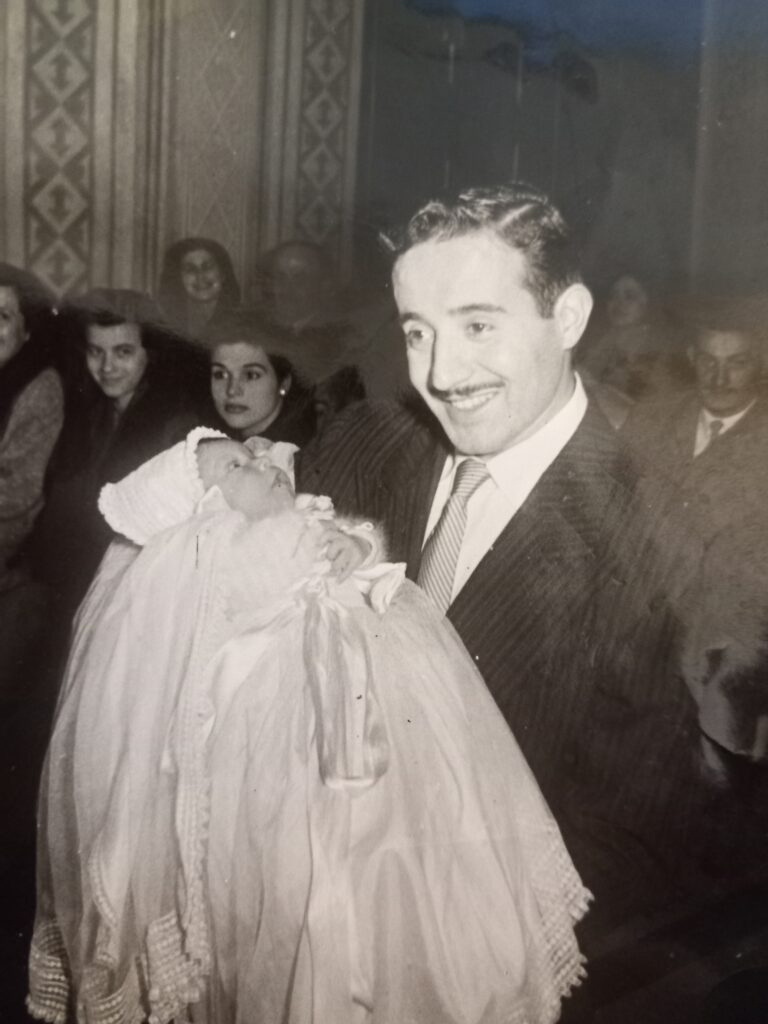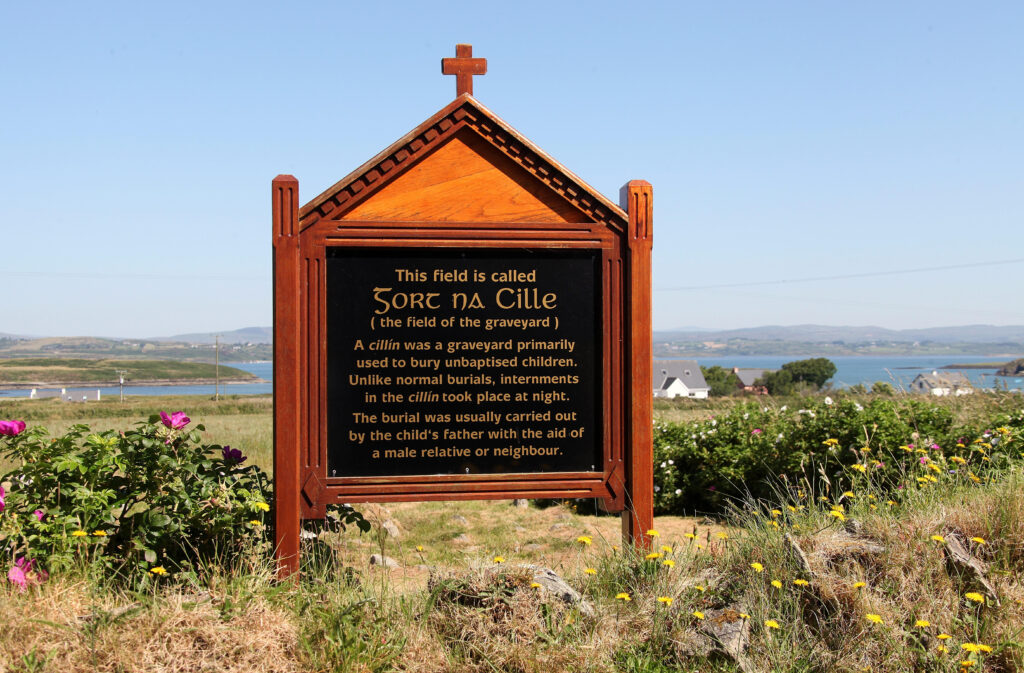By Liam Kennedy

Generations of Irish Catholic parents rushed to have their infants baptised as soon as possible after birth. In this they were different from Presbyterian and Church of Ireland families, who might wait for weeks and sometimes months before arranging the baptismal ceremony. By the later twentieth century, however, many Catholic parents were delaying baptism until an elaborate celebration could be organised for family and friends, the social seemingly taking precedence over the sacramental. This transition has been one of the silent changes in Irish society, shaped by and part of a wider process of secularisation that includes falling church attendance, rejection of Church teachings on contraception, abortion and divorce, and an acceptance of sexual relations outside marriage.
It may be that the change in the timing of baptism, which has gone largely unremarked, was more consequential than appears at first sight. The thrust of this article is that there may have been a price to pay for traditional forms of baptism. But, first, why might the Church insist on and the laity acquiesce in infant baptism?
LIMBO
The green-covered book A catechism of Catholic doctrine (1951), in which cohorts of Irish schoolchildren were schooled, holds the answer: ‘Baptism is necessary for salvation, because our Divine Lord has said: “Unless a man be born again of water and the Holy Ghost, he cannot enter into the kingdom of God” (John iii, 5)’. In the absence of baptism all infants were stained with original sin, an inherited condition of sinfulness arising from the fall of Adam and Eve. Thus some early Fathers of the Church taught that an unbaptised soul went straight to Hell. Medieval theologians modified this dire prediction by discovering or inventing a metaphysical place called Limbo, where unbaptised souls might languish for all eternity but free at least from the physical torments of Hell.
Fear of Limbo drove the waves of infant baptism. Parents had good reason to feel apprehensive. The Angel of Death might well visit the cradle of the newly born. In the early 1900s one in ten Irish children died before the age of one; a higher proportion died during the first week of life. Improvements in child mortality were slow in coming, and it was only at the end of the 1940s that an abrupt and sustained improvement came about. New drugs, antibiotics in particular, ushered in revolutionary changes in the control of bacterial infection and so gave rise to major gains in life expectancy.

CILLÍNÍ
For those parents unlucky enough to experience the death of a child before she or he had been baptised further suffering lay in wait. Most priests would not allow the remains to be buried in the family grave in the local cemetery. The graveyard was consecrated ground and the priest’s duty was to bar admittance to an infant whose soul was contaminated with original sin. Baptism alone could expunge the stain; parental pleading counted for nought. Hence the proliferation of cillíní or informal burial-grounds for the unbaptised in the Irish countryside. These resting-places were pieces of waste ground, secluded spots, or sometimes the raths or ringforts that dotted the Irish landscape. Unlike normal funerals, burials were often late at night, shrouded in secrecy and shame. Echoes of the anguish, and sometimes anger, to which this exclusion gave rise may be found in the oral recollections of women born in the 1930s and the 1940s. This pain was in addition to the larger trauma of losing a child and guilt feelings round the prospect of Limbo, so in effect a triple burden.
In the decades after Vatican II the ‘doctrine’ of Limbo fell into disuse, though in 2007 an authoritative Church commission affirmed, contrary to expectations, that belief in Limbo was still consistent with official Catholic belief (International Theological Commission, The hope of salvation for infants who die without being baptised). The Commission did, however, hope that more merciful possibilities might exist. The bulk of Irish Catholics, and possibly most priests and nuns, took the view that Limbo had been abolished and that an oppressive belief had been consigned to the dustbin of theology. Doubts about the existence of Limbo, pre-dated by falling infant mortality, cleared the way for delayed baptism. Delayed baptism is now the norm in post-Catholic Ireland, as it has been for generations among mainstream Protestant denominations.
HEALTH IMPLICATIONS?
Historically speaking, infant baptism was a fear-driven institution that was for long characteristic of Catholic religious practice. In addition to its social and theological dimensions, however, might there have been unseen health implications as well? In a paper published in the journal Demographic Research (March 2024), the authors (including this writer) found that among the three major religions in Ireland—Catholic, Church of Ireland and Presbyterian—child mortality was highest among Catholics. Presbyterians fared best, followed by Church of Ireland families. Intriguingly, Jews in Ireland had even better child mortality outcomes than any of the major denominations, possibly owing to superior childcare and hygiene practices.
These findings were for the early twentieth century. There could, of course, be many reasons for the discrepancies between the Christian denominations, differences in social class, housing and education being prime candidates. The really surprising result was that even after controlling for a dozen such confounding possibilities a visible Catholic disadvantage remained. It seems that something intrinsic to the culture of Catholic families was responsible for the tragic outcomes.
What follows is a speculative argument that links the disadvantage suffered by Catholic families to the practice of infant baptism, not just in Ireland but wherever in the world infant baptism was the norm. From the late nineteenth century up to the 1960s, possibly as a by-product of the Devotional Revolution in Ireland, newborn babies were baptised within a day or two of birth. In rural areas most of these births would have been home births. The potentially vulnerable infants were conveyed, irrespective of weather conditions and usually without the mother in attendance, to a cold chapel, where the ceremony of baptism was performed by the local priest. The infant was then conveyed back to the mother, either at home or in a lying-in hospital. There were variations on this, such as ‘emergency baptism’, which could be administered by a lay person in case of imminent death, but these were the exception.
The usual pattern meant that some infants, to varying degrees, were exposed to inclement weather, as well as possible infection from those attending the baptism ceremony. Some recent Italian research corroborates one part of this possible relationship. Francesco Scalone, a demographic historian, investigated the connection between child mortality and temperature in two mountainous parishes in the north of Italy during the period 1820–1900 and found a clear relationship between low temperatures on the day of birth and infant death. There are a handful of other Italian studies in the same vein.
In Ireland, inevitably in view of the climate, some of the newly born were exposed to environmental hazards such as cold weather, wind and rain in an era before comfortable travel and warm interiors were commonplace. The journey to and from church or chapel, sometimes four or five miles distant, by foot, horse and trap or donkey and cart, is likely to have increased the hazard. Under more exposed conditions on the Atlantic seaboard the risk must have been appreciably greater. To take an extreme example, the menfolk of the Great Blasket Island had to row an infant by curragh to a mainland chapel to avail of the services of a priest.
It is possible that the argument being sketched here is wrong-headed and is missing the real explanation. If so, then the conundrum of relatively high Catholic infant mortality remains to be resolved. But if true, or even partly true (in the sense of being one aspect of relatively poorer hygiene and childcare), there is a terrible irony. Catholic parents, in seeking to avoid the dire metaphysical fate of Limbo, ended up exposing the newborn child to a heightened risk of death. In that case, it needs to be said that the connection between infant baptism and infant death was unknown to priests and people and was an unintended consequence of a deeply ingrained religious practice founded on once widely accepted theological doctrine.
Liam Kennedy is Emeritus Professor of Economic and Social History at Queen’s University Belfast.
Further reading
L. Kennedy, ‘Afterlives: testimonies of Irish Catholic mothers on infant death and the fate of the unbaptized’, Journal of Family History 46 (2) (2020).
F. Scalone et al., ‘Neonatal mortality, cold weather, and socio-economic status in two northern Italian rural parishes, 1820–1900’, Demographic Research 39 (2018), 525–60.
